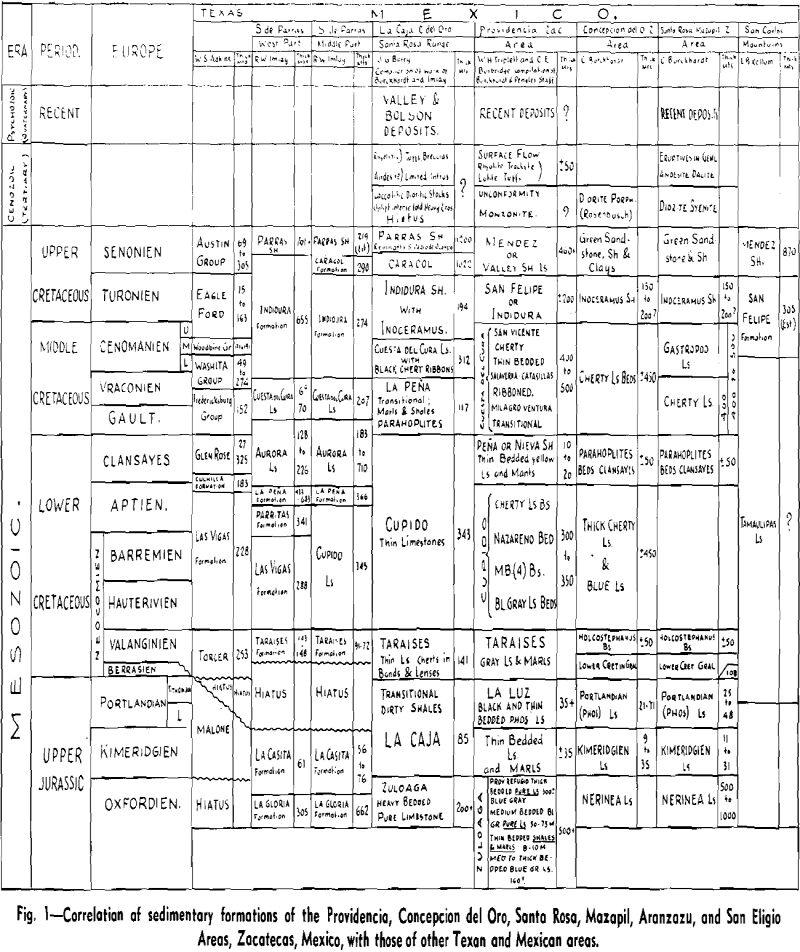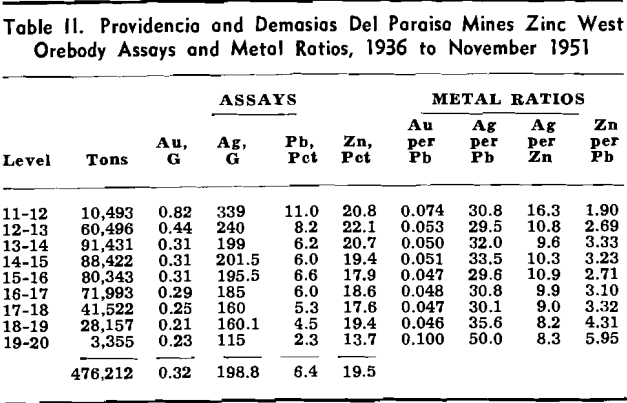Table of Contents
The Avalos unit of the Compania Minera de Penoles, S. A., operates the Alicante, Bonanza, Providencia, Albarradon, San Eligio, Nazareno, Leona, Salaverna, and Santiago mines situated between Avalos rail-road station and Concepcion del Oro on the Coahuila and Zacatecas railroad in the State of Zacatecas, Mexico. Some of these mines are within Penoles property while others are on mining claims leased from the Compania Nazareno y Catasillas, S. A., Mazapil Copper Co., and the American Smelting and Refining Co. The main office and camp are at Providencia, about 170 km southwest of Monterrey, N. L., so the silver-lead-zinc mines of the district are usually referred to as the Providencia mines.
Rock Formations
Sedimentary Rocks: Many competent geologists have contributed generously to an ample fund of information concerning the sedimentary columns of northern Mexico. Among them are Carlos Burckhardt, E. Bose, L. B. Kellum, and R. W. Imlay. Carlos Burckhardt, who covered a number of extensive areas in many parts of the Mexican Republic, devoted years to mapping the geology of the Caja, Zuloaga, and Santa Rosa mountain ranges around Mazapil, Concepcion del Oro, and San Pedro de Ocampo, Zacatecas. He did most of the original mapping which has been used as a basis and amplified by others. C. E. Burbridge and, more recently, John

G. Barry, compiled the data in the accompanying correlations of sedimentary strata, see Fig. 1.
Jurassic: Ore deposits of this district have occurred more abundantly in the Nerinea limestone of the Upper Jurassic than in any other formation. It is a moot question whether this abundance of mineral is due to the inherent physical and chemical qualities of the limestone or to its nearly uniform confined position between a large intrusive stock and overlying hornstones.
The fourth important ore horizon is the upper part of the middle Cretaceous, the thin-bedded Cuesta del Cura or Cenomanian limestone. The strata are bluish gray to yellowish in color, 10 to 30 cm thick, consistently wavy with abundant black cherts. The Santiago, Salaverna, and San Vicente orebodies all occur near the top of these wavy limestones, just beneath the Indidura (Turonian) limy shales.


The Bonanza-Providencia-San Elias-Animas-Salaverna and smaller groups of silver-lead-zinc deposits, the Concepcion del Oro copper-gold and the Santa Rosa lead-gold deposits all occur at a pronounced bend in the mountain chains where they change strike from northwest to west. The axis of this bend strikes northeast from this district through the Diente mine near Monterrey. All of the mountain chains between these two districts bend concentrically around the region herein described.
Local Structure
Jurassic Limestone Belt: The Aranzazu copper mine and the San Eligio, Albarradon, Providencia, Bonanza, Alicante, and Rusio silver-lead-zinc mines all occur in the narrow band of Nerinean (Jurassic) limestone along the southwest side of the diorite and monzonite intrusives. The narrow band, which dips 60° to 70° to the southwest, is confined between the intrusives and the overlying Kimeridgian hornstone. This is the most productive belt of the two camps.
There are myriads of small to tiny fractures, mostly N. 10 W. to N. 80 E., running outward from the intrusive. The N. 30 E. fractures, which are normal to the igneous contact and to the strata, and the N. 70° to 80° E. fractures are the only ones that have been definitely proved to be mineralized in depth. Shrink-age of the intrusives has opened up the N. 55 W. bedding planes of the steeply inclined limestones on the upper levels but not on the Providencia levels below level 11, which is about 550 m below the outcrops. They become increasingly tight on each succeeding deeper level.
Salaverna-Santiago Group: There are four branches of the Santiago Zn-Ag-Pb orebody which crop out along the contact between the Cuesta del Cura cherty limestone and the Indidura shaly limestones. The sedimentaries are intensely folded and irregular, but the branches were followed downward approximately along the contact until they came together into one larger body. They are now being worked downward, but they go down a little more steeply than the bedding. The Salaverna is a single irregular body in the intensely folded Cuesta del Cura limestone. Though steeper than the dip of the strata, the latter is the main guide in following the ore in depth.
Silver-Lead-Zinc Ores
The greatest production of the district, by far, has come from the many steeply inclined chimneys in the Zuloaga (Nerinea) limestone corridor between the quartz-monzonite intrusive and the metamorphosed Kimeridgian limy shales.
It is not known whether the large main ore shoots are of post lava capping age or not, but there is one small ore shoot in the Luz mine which outcrops in the capping rock, so the other larger shoots may also have had an overlying felsite roof. Even though the larger bodies may have gone through the capping, this roof may also have had a retarding influence which tended to increase replacement in the underlying limestones.
On the upper levels, each ore shoot replacing a certain steeply inclined limestone bed or series of beds tended to stay with the same bedding as it was developed downward, but occasionally it stepped across into the foot wall to an underlying bed. Some of the smaller shoots, occasionally dipping more steeply than the strata, reached the intrusive contact in the oxidized zone. At this point they consisted of masses of very low grade iron oxides.
Referring only to the orebodies in the narrow corridor between the intrusive and the hornstone hanging wall, the ore shoots are most numerous near the intrusive. They terminate with their roots at the igneous contact and contain more iron than those farther away. Many Alicante and Refugio and a few Providencia bodies are examples of this habit. The bodies farther away from the intrusive reach greater depths before becoming very pyritic and terminate only when the proportion of pyrite and unreplaced limestone renders them noncommercial.
Some of the outcrops that have not responded to exploration contain abundant calcite and barite, but only small quantities of iron oxide, arsenates, cerussite, calamine, antimony oxides, sulphide, galena, and sphalerite. Occasionally there are a few specks of cinnabar. Quartz is often abundant. The conspicuous difference between the productive and unproductive outcrops is the relative abundance of iron oxides.

Trenching revealed three other similar prospects under covers of caliche. Samples from these assayed:

No investigations have been undertaken to identify different periods of mineralization, but many observers have noticed that the oxidized iron in the N. 70° to 80° E. fractures of the Alicante and Refugio mines carry several grams of gold where they cross the base metal ore shoots. The highest assays are found associated with mimetite.
Replacement was not as complete on the lower levels as the upper ones, and the result is that an ore shoot resembles the trunk of a limbless tree with a lot of tenuous rootlets. At Ojuela, Durango, the gradual pinching out of the orebodies is distinctly different.

At Providencia, the transition zone consisted of semistratified layers of mud, sand, pieces of limestone, chunks of carbonate ore, and some leached silicious irony material in place overlying semi-oxidized sulphides, which were low in grade. Only a part of the muddy sandy material was minable. There are also evidences of higher transition zones at levels where the water level apparently stood for long periods of time.
In the Leona and Nazareno mines the Animas ore chimneys, which are not oxidized as deeply as the Zinc West, were also comparatively rich in precious metals immediately below the transition zone. This was probably due to secondary enrichment.

